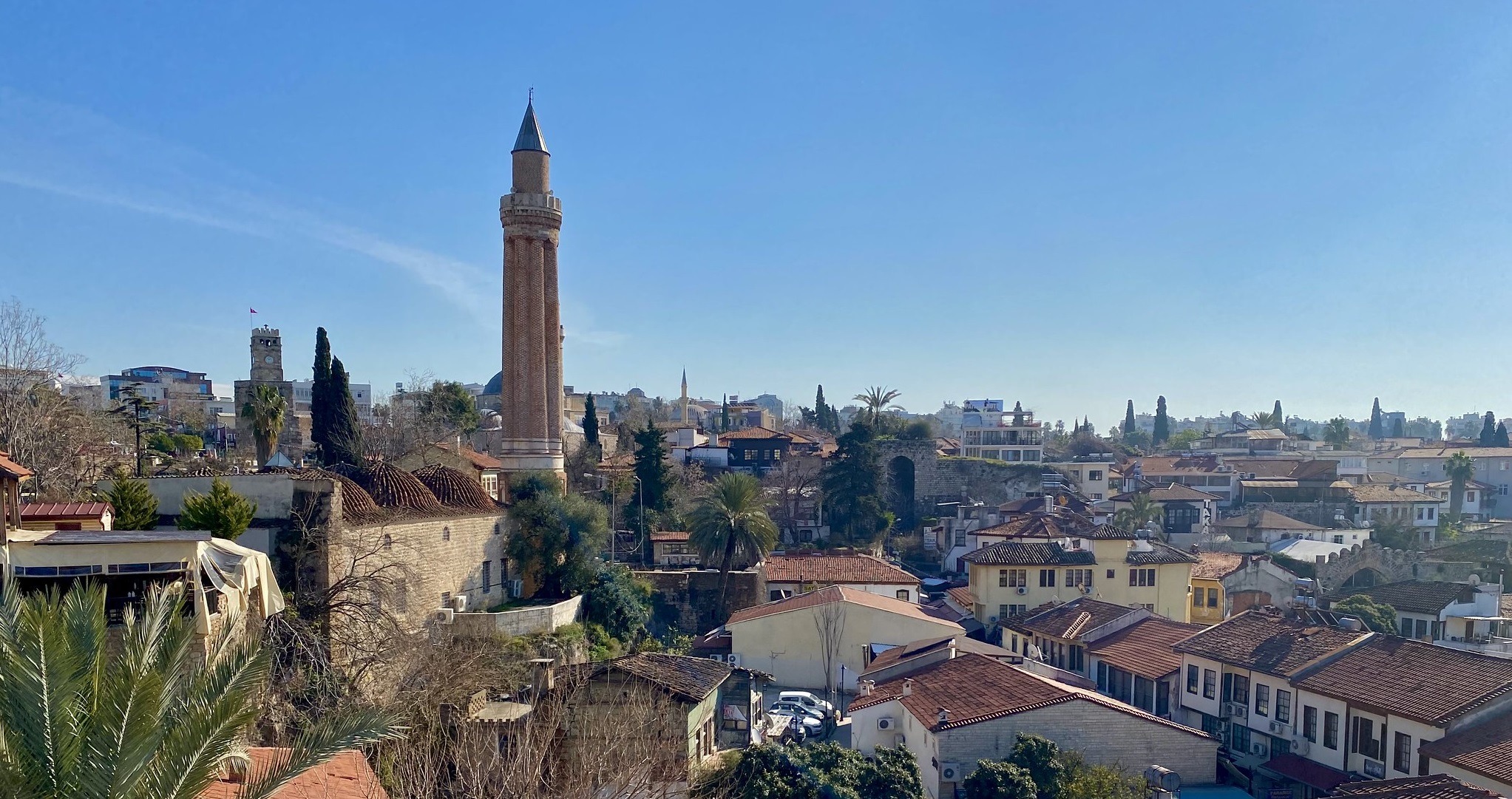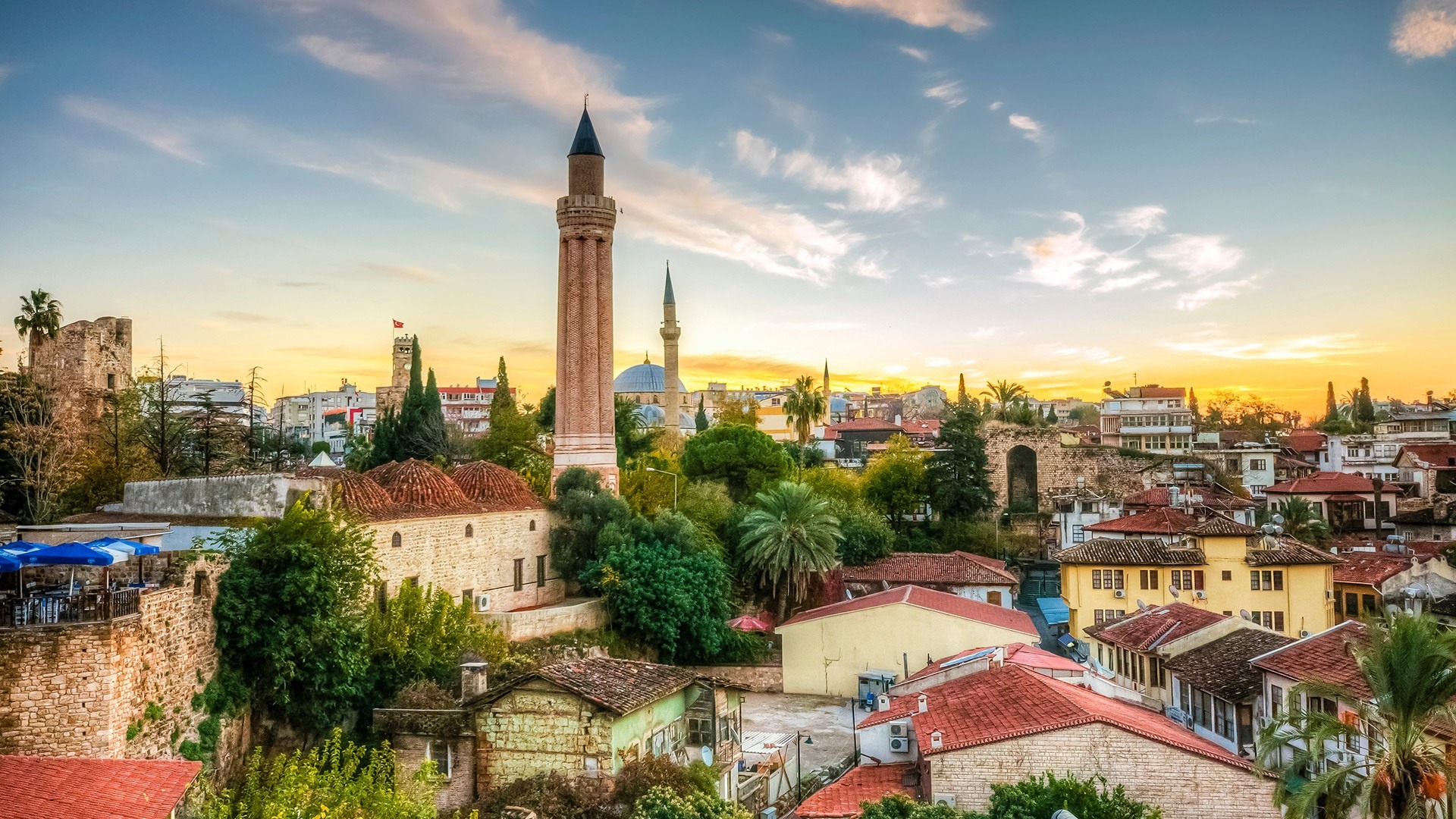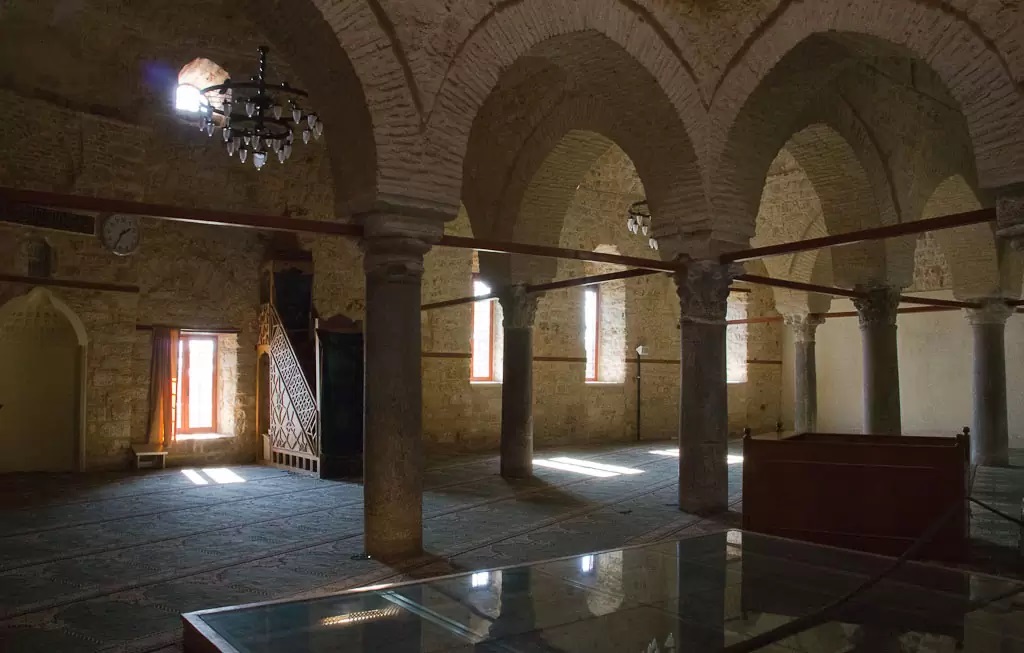Yivli Minaret is located in the Muratpaşa district of Antalya and is one of the city’s most famous historical landmarks. Built in the 13th century during the reign of Anatolian Seljuk Sultan Alaeddin Keykubat I, this structure is notable for its eight fluted body, from which it derives its name. The approximately 38-meter-high minaret is constructed from brick and decorated with turquoise-colored tiles. Initially, the site was occupied by a Byzantine church; a mosque was later added, transforming the area into a religious complex (külliye) over time.
The Yivli Minaret is not only an architectural structure but also symbolizes Antalya’s transition into the Islamic era. In addition to the mosque, the complex includes structures such as a madrasa, tomb, and Mevlevihane (lodge for Mevlevi dervishes). Today, tourists visiting Kaleiçi do not leave without seeing this historical landmark, which stands out for both its architectural elegance and its cultural heritage. The illuminated view of the minaret, particularly in the evening, attracts great interest from both local and foreign visitors.
Where is Yivli Minaret located?
Yivli Minaret is located in the historic Kaleiçi district, near Kalekapısı Square in Antalya’s Muratpaşa district. Positioned in the city center, it is one of Antalya’s best-known landmarks and can be seen from almost every point. Access to Yivli Minaret is quite easy; city buses, tram (Antray), and taxis provide convenient transportation. Additionally, visitors can reach this impressive structure by walking through Kaleiçi’s narrow, historic streets. Nearby parking facilities also offer convenience for visitors arriving by private vehicles.
When and by whom was Yivli Minaret built?

It was built during the reign of Anatolian Seljuk Sultan Alaeddin Keykubad I, in the early 13th century. The construction inscription on the minaret states that the structure was built during the time of Sultan Alaeddin Keykubad (1220–1237). The minaret was constructed with bricks on a square-cut stone base and is notable for its eight fluted (grooved) body. It has survived to the present day as one of the original examples of Seljuk architecture.
What are the architectural features of Yivli Minaret?
Yivli Minaret is considered one of the unique and impressive examples of Seljuk architecture. Its most striking feature is the eight fluted (carved) vertical projections on its body. These flutes give the structure both an aesthetic appearance and architectural elegance. The minaret, approximately 38 meters high, is built with bricks on a square-cut stone base. Its body is constructed from brick and includes areas decorated with turquoise-colored tiles. The minaret is accessed via a staircase with 90 steps, and the balcony (şerefe) section is designed in a simple form.
The architecture of the minaret reflects the aesthetic approach of the Seljuk period while combining functionality with ornamentation. The geometric patterns created with brick craftsmanship and the structure’s solidity demonstrate the engineering success of the time. Yivli Minaret should not only be viewed as a minaret but also as a part of the religious complex (külliye) in which it stands; together with the surrounding mosque, madrasa, and tomb structures, it forms an important element of Antalya’s historical skyline. This holistic architectural concept provides insight into the urban planning and religious life understanding of the era.
Where does the name “Yivli Minaret” come from?

The name “Yivli Minaret” comes from the eight vertical fluted (carved) projections on the body of the minaret. This fluted design not only gives the minaret an aesthetic appearance but also distinguishes it from other classical minarets. The word “yivli” in Turkish means “grooved” or “fluted,” and this architectural feature is the reason the structure was named “Yivli Minaret.” With its unique form, the structure has become one of the symbols of Antalya.
What other structures are found in the complex where Yivli Minaret is located?
The complex in which Yivli Minaret is located was designed as a religious and cultural center from the Seljuk period and includes several historical buildings. In addition to Yivli Minaret, the complex features Yivli Mosque, Gıyaseddin Keyhüsrev Madrasa, Seljuk Madrasa, Mevlevihane (Mevlevi Lodge), Zincirkıran Tomb, and Nigar Hatun Tomb.
These structures reflect the architectural understanding of the Seljuk period and the multifunctional nature of religious complexes, built to meet various social needs such as worship and education. Today, this complex attracts visitors as a significant part of Antalya’s cultural heritage.
What is the restoration history of Yivli Minaret?

The restoration history of Yivli Minaret has been shaped by various efforts carried out over time to preserve the structure’s historical and cultural significance. The first major restoration was conducted in 1373 by Mübarizeddin Mehmed, the son of Mahmud, the son of Yunus. During the Republican era, restorations were carried out in 1935, 1942–1943, 1953, and 1964. A fire that broke out in the complex in 1972 caused damage to the northern and southern parts of the mosque and harmed the tile decorations. As a result, comprehensive restoration works were carried out by the General Directorate of Foundations in 1973 and 1977. Most recently, in 2007, surface cleaning of the mosque walls was performed, and deteriorated brick and stone claddings were repaired.
In recent years, more extensive restoration and archaeological excavations have been conducted on Yivli Minaret and its surrounding structures. In these works, led by the General Directorate of Foundations, student cells, main iwan sections, and numerous graves have been uncovered in the Atabey Armağan Madrasa. Additionally, the original stone pavements of the madrasa, column bases, three student cells, and the wall structure of the main iwan have been revealed. These findings provide significant insights into the architectural features of the madrasa.
During the restoration works, 40 graves were found in the area surrounding Yivli Minaret and were relocated near the Mevlevihane. Furthermore, construction work is ongoing on annex buildings on the mosque’s northern side, which will include ablution facilities.
These restoration and excavation efforts aim to preserve the historical fabric of Yivli Minaret and its surrounding structures and to pass them on to future generations. At the same time, these works allow for a better understanding and documentation of the architectural and cultural features of the Seljuk period.
How to get to Yivli Minaret?

Yivli Minaret is located in the Kaleiçi neighborhood of Antalya’s Muratpaşa district, near Kalekapısı Square. As one of the city’s landmarks, this historical structure is very easy to reach.
By Public Transport:
Tram: Antray’s T1A and T1B lines stop at Cumhuriyet Square, the closest station to Yivli Minaret. From this stop, you can reach the minaret with a short walk.
Bus: The following bus lines pass near Yivli Minaret:
- KL08: Sarısu Storage – Güzeloba
- KL08G: Sarısu Storage – Güzeloba
- KC34: Gürsu – Altıntaş
- LF09: Ünsal Storage – Güzeloba
- MC12A: Masadağı – Meydan
- TC16: Ünsal Storage – Ermenek
- UC32: Sarısu – Demirciler Bazaar
You can take any of these routes, get off at the Cumhuriyet Square stop, and reach Yivli Minaret with a short walk.
By Private Vehicle:
Yivli Minaret is very close to Antalya city center and is accessible by private vehicle. By following signs directing to the Kaleiçi area, you can reach Kalekapısı Square. There are parking areas in the vicinity, but due to narrow streets and congestion, finding a parking spot might take time. Therefore, public transportation or taxis may be a more practical option.
On Foot:
If you are in the city center and prefer to walk, you can enjoy a pleasant stroll through the historic streets of Kaleiçi to reach Yivli Minaret. During this walk, you’ll also have the chance to explore Antalya’s historical atmosphere closely.
Note: To get the most up-to-date public transport information and routes to Yivli Minaret, you can use the Moovit app.
What is the historical significance of Yivli Minaret?

Yivli Minaret is considered one of the most important structures reflecting the Islamic architectural period of both Antalya and Anatolia. Built in the 13th century by Seljuk Sultan Alaeddin Keykubad I, it is one of the oldest Islamic structures in Antalya and stands as an original example of Anatolian Seljuk architecture. With this characteristic, it has become the most prominent symbol of the Seljuk era in the city and has gained historical significance as both a religious and cultural center throughout history.
At the same time, Yivli Minaret is not merely a place of worship; along with the surrounding complex, it also includes social and cultural structures such as a madrasa, tombs, and a Mevlevihane (dervish lodge), forming a multifunctional complex. In this sense, the structure offers significant insight into the urban planning and lifestyle of the Seljuk period. Today, with its architectural elegance and historical meaning, Yivli Minaret has become a symbol of Antalya and continues to attract the interest of many local and foreign visitors.
What is the height of Yivli Minaret?
Yivli Minaret is 38 meters tall. It is a structure notable for its eight fluted vertical sections and is accessed by a staircase of 90 steps. The base is made of cut stone, measuring 6.5 meters in height and 5.5 meters in width. The body is built from brick and decorated with turquoise tiles. With these architectural features, Yivli Minaret has become one of the iconic landmarks of Antalya.
Can the interior of Yivli Minaret be visited?

Yes, the interior of Yivli Minaret can be visited; however, it is the Yivli Minaret Mosque, which is part of the complex, that is open to visitors—not the minaret itself. Yivli Minaret Mosque is open to visitors outside of prayer times, and entry is free. Visiting hours are generally between 08:00 and 18:00, though these hours may vary depending on the season.
However, the interior and the balcony section (şerefe) of the minaret are closed to visitors due to safety and preservation reasons. Therefore, it is not possible to tour the inside of the minaret. Still, the interior of the mosque features beautiful examples of Seljuk architecture and offers visitors a historical atmosphere.
During your visit, you can explore the mosque’s interior and closely examine the architectural details of this historic structure.
